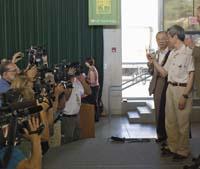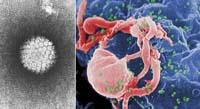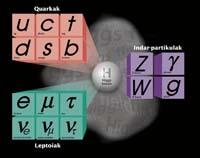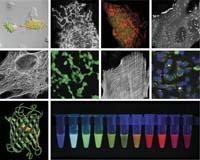Nobel Prize 2008

And the American Robert Gallo has not been awarded. However, many consider it an HIV discoverer along with Montaigner, so it does not seem fair to them that the Nobel Foundation does not grant him the prize. Montaigner himself, when he was told that he won the Novel, was surprised. The journal Science expressed its "penalty" by Robert Gallo.
Although these statements make us think about something else, these two men have spent years facing each other, discussing who was the first HIV discoverer. After the debate there was money: the benefit obtained by the patent of the AIDS diagnostic test.
Finally, in 1987, Ronald Reagan and Jacques Chirac held the debate indicating that the discoverers of the virus were equally and that the benefits of the patent would be distributed equally between the two countries. And in 2002 two researchers wrote an essay in the journal Science, where they wrote that the work of both to find the virus was essential.
However, the Nobel Foundation has decided to award the prize based on who published its first article on the discovery of the virus, and there is no doubt that the first article signed by two researchers, one is Luc Montaigner and the other, a woman who has so far been hidden. It is called Françoise Barré-Sinoussi and soon will receive the prize next to Montaigner. All merit.

Physiology or Medicine novel by discovery of human papillomavirus and AIDS
Harald zur Hausen, and Françoise Barré-Sinoussi and Luc Montaigner
The first to "discover the types of human papillomabirus causing cervical cancer" and the other two to "discover the human immunodeficiency virus"
The Novel of Physiology or Medicine will be given equally to those who identified the causes of two serious diseases. Half is directed to researcher Harald zur Hausen for identifying human papillomavirus and demonstrating that it is the cause of cervical cancer. The other half, in equal parts, is for researchers Françoise Barré-Sinoussi and Luc Montaigner for identifying the human immunodeficiency virus (HIV).
Human papillomabirus, causing uterine cancer

After years of work, he managed to identify the human papillomabirus in the cancer cells of the cervix and realized that there are several types: some produce cancer and others do not. He differentiated between them and showed what gives the former the ability to cause cancer.
Thanks to the work carried out by Hausen, much progress has been made in the detection and prevention of cervical cancer, as currently there are vaccines that protect against the two most malignant types (genotypes 16 and 18).
HIV, which causes AIDS
A new disease was described in the United States in 1981. It was called AIDS and by various characteristics (groups of patients, lymphocyte loss, blood transmission) it was suspected that the agent had to have a retrovirus, and some groups of researchers were put in their search.
In 1983 the study of lymphocytes removed from the patients of Barré-Sinoussi and Montaigner began, cultures are made and remnants of the retrovirus are sought. Lymphocytes grown in cultures saw a reverse transcriptase, an enzyme that uses retroviruses to reproduce. In addition, they demonstrated that cultural lymphocytes released virus particles that contaminated healthy lymphocytes. This virus was isolated and known as LAV (lymphadenopathy associated virus or lymphadenopathy-related virus). Then the AIDS virus was associated and it was called HIV, the human immunodeficiency virus.

Discoveries on Symmetry Ruptures at the Nobel Prize in Physics
Yoichiro Nambu, Makoto Kobayashi and Toshihide Maskawa
To the first to "explain the rupture of symmetry proper to subatomic physics", and to the other two to "discover the explanation of the rupture of symmetry that preached at least three families of quarks"
The Standard Model of Physics describes the world of basic particles. According to him, elementary particles are divided into three families. But it has not always been so, to reach this model physicists have had to overcome a series of obstacles.
One of the problems was that elementary particles were supposed to comply with the laws of symmetry. But little by little the experiments showed that in some cases the symmetry was broken, which put into question the model of the time. No one knew why that was happening. And in 1972, young researchers Makoto Kobayashi and Toshihide Maskawa - both in calculations of quantum physics - found the solution: to understand the rupture of symmetry it was necessary to have three families of quarks.

Origin of the Masses
Since then, the Standard Model divides the basic particles into three families. The heavier particle of the model (top quark) is 300,000 times heavier than the lighter (electron). Why this kind of difference?
Most physicists consider that the cause is another rupture of symmetry: Higgs mechanism. According to this theory, in the early phases of the universe, the Higgs mechanism broke the symmetry between forces, giving different masses to the particles.
The first stone of this theory was put by Yoichiro Nambu in 1960, when he created the idea of breaking his own symmetry. Nambu worked on the theoretical calculations of superconductivity. And later he applied the natural rupture of symmetry that occurs in this phenomenon to the world of elementary particles. His mathematical tools have been fundamental to understanding the current Standard Model. That's why Namburu has been given the other half of the prize.
Fluorescent green protein at the Nobel Prize in Chemistry

Osamu Shimomura, Martin Chalfie and Roger Y. Tsien
"For the discovery and development of fluorescent green protein (GFP)"
The fluorescent green protein (GFP) was first seen in the medusa victory in 1962. Since then, the protein is very interesting for scientists, since it is very useful for many trials. For example, it allows to observe the growth of tumors and brain development of Alzheimer's disease. Specifically, this protein can be used to know the chemical reactions that occur in cells. For this purpose, the protein adheres to the molecule that interests the scientist and emits fluorescence by absorbing light from the outside. Thus, the molecule that he wants to see remains in view of the scientist.
Medusa light
Osamu Shimomura isolated the fluorescent protein GFP from the jellyfish Aequorea victory.

After all these investigations, the American Chalfie proposed the application of the GFP protein to the activator gene of a complete process to observe the processes initiated by this activating protein. Green light would clarify all these processes.
Finally, Roger. And Tsien studied the reaction mechanism and found that replacing these three essential amino acids absorbed and emitted light from other areas of the spectrum. After several amino acid junctions, the American researcher discovered that the GFP emitted cyan, blue and yellow. Thanks to this, today, researchers can mark proteins with different colors to analyze, among other things, their interactions.
Buletina
Bidali zure helbide elektronikoa eta jaso asteroko buletina zure sarrera-ontzian











